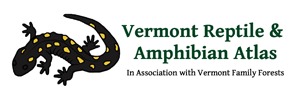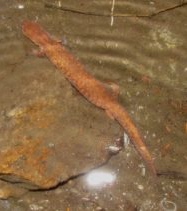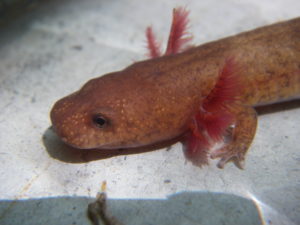Gyrinophilus porphyriticus
Identification 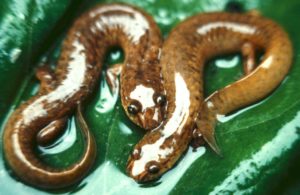
The Spring Salamander is one of the larger salamanders in Vermont; the average length of a large adult in Vermont is 7.5 inches (the longest documented in Vermont can be viewed here). It is salmon-pink to reddish with black mottling. White lines outlined in black run from their eyes to their nostrils. Their tails are laterally compressed (like a fish) and all of their legs are thick and strong.
Spring Salamanders lay 16-160 eggs attached to the underside of rocks in the water. Their larvae have feathery external gills and live for eight years and grow to about 5 inches long before becoming terrestrial. Some people confuse the larvae with Mudpuppies but Mudpuppies are heavily striped when young and they do not live in mountain streams.
Get more detailed identification and life history information by downloading the chart here.
You can learn more about this species and see some video footage by checking out this clip from our Rattlers, Peepers & Snappers DVD or this video on stream salamanders in the Green Mountains.
Range/Habitat
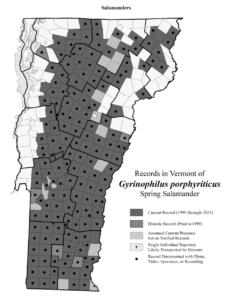
[ click image to zoom | download printable PDF ]

[ click image to zoom | download printable PDF ]
The Spring Salamander requires well-oxygenated, cold, clear mountain streams or springs. On rainy nights they feed on land in the vicinity of the stream.
The Spring Salamander is found statewide in or near mountain streams.
Status
Spring Salamanders have a state natural heritage rank of S4 (relatively common). Please report sightings of this species in Vermont if you have not reported them within the last five years from a given location. Any natural history observations (feeding, migrations, road crossing areas, early or late season appearance, abnormalities, etc.) are appreciated. Photographs are always helpful, particularly if your report is the first report of this species from a town.
Additional Photos
More Info
- Gyrinophilus porphyriticus at Animal Diversity website
- Gyrinophilus porphyriticus at Amphibiaweb
- Gyrinophilus porphyriticus at the Canadian Herpetological Society website
- Gyrinophilus porphyriticus at the Yale Peabody Museum of Natural History website
Species summary written by Ariel K. McK. Burgess.
